Media | Articles
How I built a ’57 Ford stocker to honor my father’s circle track legacy
(Hagerty Drivers Club member John Nece passed along this heartwarming tale. If you would like to see your car featured on the pages of this website, email editor@hagerty.com . –Ed)
My father, Ray Nece, was the first and only four-time dirt track champion at Mt. Clemens Race Track—a now-defunct bullring just north of Detroit. It was his hometown track and became a personal playground throughout the 1960s and ’70s.
Born in 1934, he started racing by the age of 17. During his career he competed in some of the most prestigious dirt track races of the era including the Pittsburgher 200 at Heidelberg Speedway in Pennsylvania, the World 100 at Ohio’s Eldora Speedway, and the Hillbilly Hundred deep in the woods of West Virginia. He won the latter in 1968.
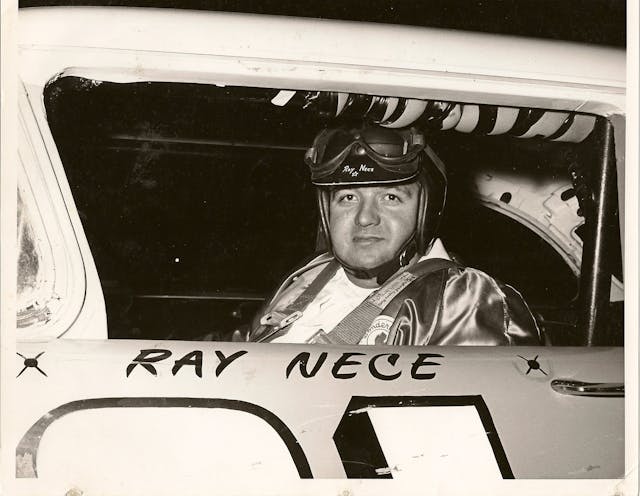
In 1973, he retired from stock car racing. He couldn’t shake the bug and returned to oval competition, this time driving an Offy-powered midget in the American Midget Racing Association. He finished fifth in points and won Rookie of the Year honors.
My Dad passed away in February of 1985 while vacationing in Daytona Beach during Speedweeks. He is a first-ballot honoree in the Michigan Motor Sports Hall of Fame and was inducted in 1989.
Marketplace
Buy and sell classics with confidence


I always wanted to honor my father in some way. I thought that building a replica of his 1957 Ford stock car would be neat way to commemorate the man and his Hall of Fame racing career, so I started searching the internet for a project car.
One day, at lunch, I found a similar stocker on eBay. After I won the auction, I drove out from my home in Michigan to Wisconsin to meet the seller Randy Conner, in the winter of 2006. Conner built and raced the Ford at Rice Lake Speedway in the Cheese State. He wanted to sell it in order to build a 1968 Falcon stock car for the coming season.
The 1957 Ford was an excellent starting point, and much easier than starting the project from scratch. Still, life got in the way, and progress was slow. I had the car for nine years when promoter Bob Larivee, asked in the spring of 2015 I could get it done in time for Detroit Autorama the next year. Larivee is known as one of the founding fathers of Autorama, helping establish Detroit’s premier indoor car show back in the 1950s. He was also a circle track racer and a close friend of my father’s.
I told Larivee I would have the car ready. The clock was ticking.
Luckily, I have a very dedicated and talented group of friends. My buddy Wally VanVyve supplied his pole barn to wrench. We got busy on the car, stripping it down to bare metal and making it look just as my Dad’s car did some fifty years earlier.
It was a lot of fun to match the Ford to its appearance back in the day. As a little kid, I soaked up everything while my dad raced. We would spend three nights a week racing at Mt. Clemens. At first, I tried to replicate everything down to the last nut and bolt, but it started turning into a job. I thought, “That’s not the reason I want to do this project.” I relaxed a little bit on my requirements and people still think it is the actual car.
For example, it says “427 C.I.” on the replica car’s hood. Even though my Dad always ran 427 big-blocks back in the day, I considered a 390-cubic-inch big-block between the car’s frame rails. I asked myself, “Should I spend a lot of money for an authentic 427 race engine, or should I put together a nice 390 to enjoy at car shows and parades?”
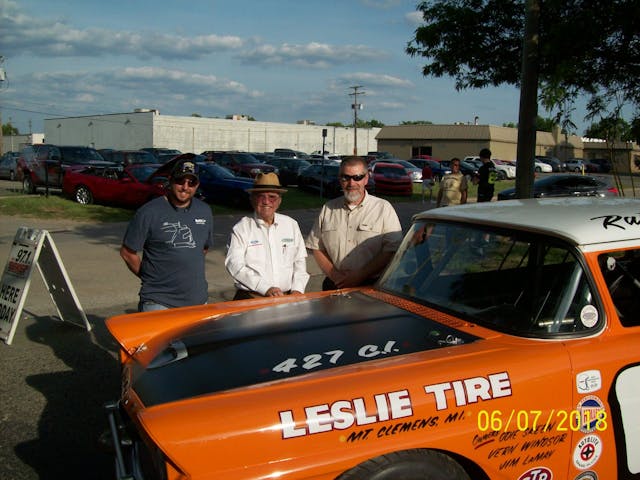
We removed the 302 cubic-inch small-block V-8 and C4 automatic transmission that came with the car and replaced it with the 390 FE and a four-speed manual Ford Toploader transmission. The engine was built at John Vermeersch’s (more on him later) Total Performance engine shop in Mt. Clemens, Michigan. The transmission was acquired through retired NASCAR team owner Tex Powell in Ether, North Carolina.
We were able to get close on a lot of things, thanks to a lot of help from fellow Midwesterners. We sourced a 1958 Ford hood to match the original car, as well as a ’58 bumper. (They were taller and could take more abuse than the ’57 bumper.)
Period-correct wheels were fabricated by lifelong-friend and late model stock car champ Larry LaMay, along with VanVyve. Even better, they built the wheels at 1988 ARCA stock car champ Tracy Leslie’s tire shop also in Mt. Clemens. For rubber, we used tires had been used in actual 1960s race competition on a dirt stock car driven by Erv Baumgarten, one of Dad’s biggest rivals. They were sitting in Baumgarten’s garage since he retired from racing in the mid-1970s.
Body and paint were done by Brian Norton, another successful Michigan stock car racer at Flat Rock Speedway. The old-school hand lettering was applied by Dennis Schalm. As a youngster, Schalm hung around Mt. Clemens and developed into a talented sign painter. In the mid-1980s he became known as the guy to see when you needed to have your car lettered. My dad was his favorite driver growing up, but he never had the opportunity to letter one of his cars, so it was cool to have him paint the ’57. Several other very good friends—including Chuck Mack, Terry McKay, Paul D’Lugopolski, Jimmy Gullett, Larry Guzdziol, Tom Tignanelli, and Leo Begu—lent their time and applied their talents throughout the course of the build.
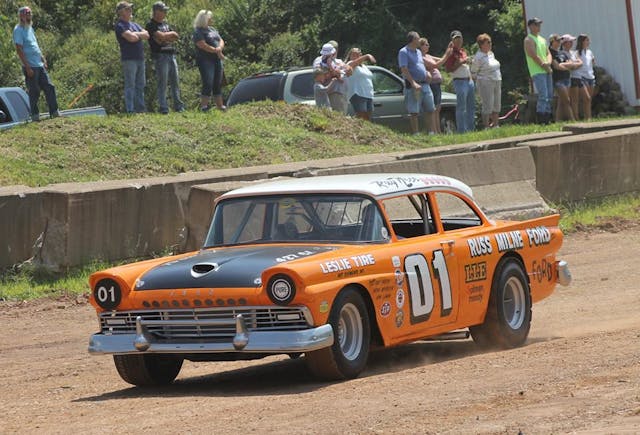
I first met John Vermeersch in 1978. In 2014, while dining with John and a group of friends at a local restaurant, I mentioned how I would love to someday own a C-Series ramp truck like Dad’s to go along with the tribute stocker.
John looked across the table and said, “I’ve got one of those trucks in my pole barn.” He told me to stop by his house the following Saturday so I could take a look and see if I might be interested in it.
When I saw the 1965 Ford C-600 sitting in John’s pole barn I immediately knew that I wanted it. The body and ramp bed were in primer. I crawled under it and slid across the floor, front to back. There wasn’t any rust to even be slightly concerned. We took the truck for a test drive and found it to be in very good mechanical condition.
However, there was one small problem: I was worried that I had showed my hand at dinner. My Dad taught me at a very young age to never look too interested when purchasing a vehicle (of any kind!) so I stalled for as long as I possibly could. After several months, John and I came to an agreement and made a deal.
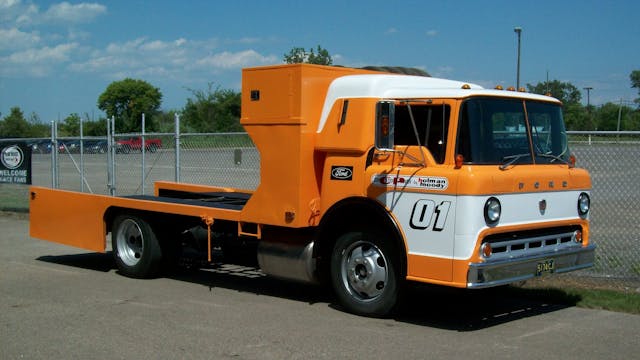
I drove the truck for about a year before taking it to Brian Borowski’s Premier Finishes collision shop in Roseville, Michigan where his crew massaged, sandblasted, and painted my truck.
We beat my imposed deadline for Autorama by one month and debuted the car at the 50th Anniversary Michigan Auto Racing Fan Club banquet, in January of 2016. Then, we turned heads at Autorama. Since then, my cousin—and “crew chief”—Tony Kline and I have attended approximately forty car shows and events from West Branch, Michigan to Pennsboro, West Virginia.
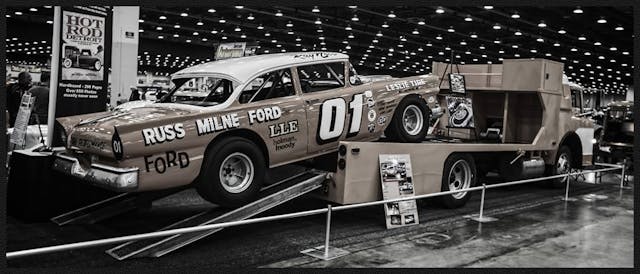
One of the highlights so far has been pacing the field of Lucas Oil Dirt Late Models for the 50th running of the “Hillbilly Hundred” at the Tyler County Speedway in Middlebourne, West Virginia in September, 2018. Fifty years later, my father’s 1957 Ford was back out in front of the field, all thanks to some late nights and great friends.
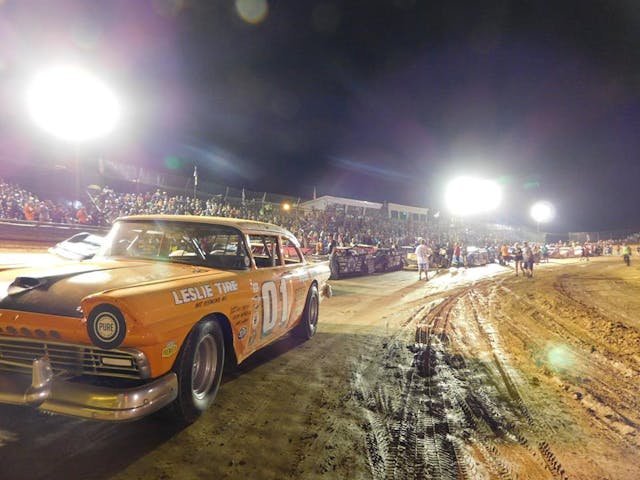
***
Check out the Hagerty Media homepage so you don’t miss a single story, or better yet, bookmark it. To get our best stories delivered right to your inbox, subscribe to our newsletters.
Via Imola






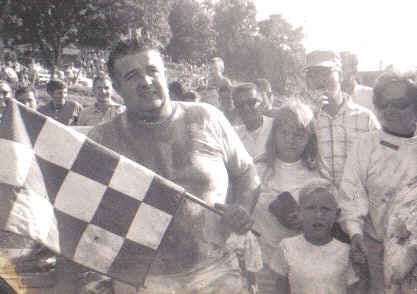



What a great story and a super tribute to a top-notch racer. Your dad is certainly beaming with pride at what you have done to honor him and his career. And the Ford is really a gem to look at! 👍👍👍
Awesome story. I think 57 Fords look great done like this. In the last 10 years I have gained a huge appreciation for those C-series Fords. I’d love to see a Ridler competing shop do a C-series up as a lowered shortbox and make the lines/proportions work (a real challenge I would think).
I have longstanding thoughts of a road legal old-style stock car. A stalled 39 Nash project a family member has had for 30s years is sometimes inspiration, a 52 Chev parts car behind my dad’s barn is another.
I agree that the hauler is VERY interesting – it deserves a story all by itself!
That hauler reminds me of our racing days. We usually flat towed the car to the track as it was only about 5 miles of back roads.
For the county fair we had to haul it somehow as it was over 20 miles away. My friends father allowed us to use the farm truck a flat bed version of the hauler. We fabricated some ramps and went off to the races.
Super cool! I grew up watching John race at Mt. Clemens Race Track! Along with a lot of people he named in the article. I have seen that car several times in Metro Detroit. Beautiful car and a great tribute!
It was an absolute honor to letter this car. My father passed away in 1972 when I was 16. He used to grade Mt. Clemens Race Track for as long as I can remember. Ray I guess took a liking to me. As a teenager with just my mom now supporting my sister and me. Money was a bit tight. Ray used to pay me to run errands for him while he was at work, as a salesman at the Ford dealer on the quarters of this car. Tires here, Race car parts there, custom wheels customers wanted on their new car. Things like that. I was as grateful to be his “gofer” as I was for the money.
As John said, I took a liking to the lettering on the race cars as a kid. I was helping another friend, Rich Peltier, on his race car. When the guy came over to letter it, I built up the courage to ask him if there was some way I could get a job with him as an apprentice. Ron Leigh, 4 Star Sign Co. took me under his wing and took some raw talent I guess I had and turned me into a reasonably good sign painter. Being an “insider” at the local track I was able to build a decent following of customers. I kept my prices down to get my name out and I think it raised the level of even the Hobby Stocks because those guys could afford someone. Those connections got me known “in the real world”, and I had a career now going for me.
As I grew up from then, I either raced myself, worked on the safety crew, or as a crew member. That allowed me to move my way through racing to end up as an ARCA official. My health failed me at a young age, 45. And forced me to retire at 50. Twelve years of never picking up a lettering quill, then John asked me if I would be interested in taking on this project. For me, it was a chance to take me full circle in my racing life. It took me 3 days of being alone while working on it. A lot of wiping off and redoing parts, to do what used to be a 6-8 hour job. All I could hope for was that John and the rest of the family thought I did the project justice.
Sounds like I did . . .
Ray’s original ’57 ended up in Carl Scholtz’s junk yard, along with Jim Holloway’s #16 Studebaker and my #5 ’56 Chevy. I wanted to restore my ’56 and at least save the other 2 from the crusher. Carl would drive down to Florida every speedweek with a big truck to buy doors and other body parts from southern vehicles. I live in Georgia, and tried to buy the 3 and bring them down on his way south. It didn’t happen. I believe he couldn’t get them out of the frozen ground. Later, I heard he tried, but they were real fragile and fell apart. Lots of familiar names I haven’t heard in ages. Smiling. Beautiful ’57. Great work Dennis.
l